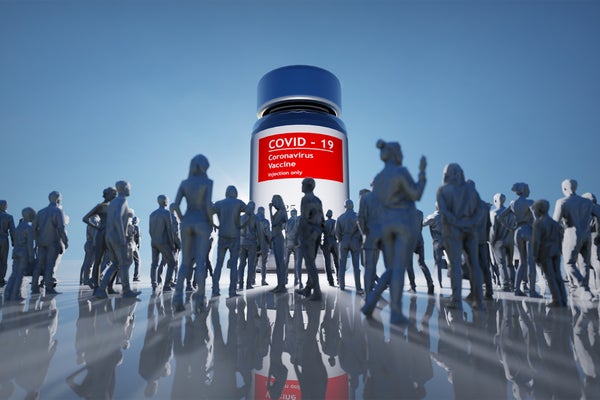At the height of the pandemic, unions across the U.S. demanded better COVID safety and health protection. From hospitals to fast food stands, warehouses to libraries, workers fought for personal protective equipment, cleaner workplaces, hazard pay and, where possible, telecommuting. To win protections, they signed petitions, organized sickouts, filed grievances, collectively bargained and, in some cases, engaged in work stoppages.
But what about vaccines? Unions helped there too, it turns out, a reality that carries a vital public health message for preparing for the next pandemic.
If we want more people vaccinated and safer workplaces, we need more unions. Unions are good medicine, as the pandemic revealed.
On supporting science journalism
If you're enjoying this article, consider supporting our award-winning journalism by subscribing. By purchasing a subscription you are helping to ensure the future of impactful stories about the discoveries and ideas shaping our world today.
Despite unions leading to improved health outcomes for workers during the pandemic, news stories about vaccines focused largely on their reluctance—or even opposition—regarding employer-based vaccine mandates. Upon closer examination, however, it becomes clear that many unions that questioned mandates had also simultaneously promoted vaccination among their members. That included educating them about the safety and effectiveness of vaccines and even hosting vaccine clinics for members and the broader community. They did this all while also opposing unilateral mandates by employers. The main objection wasn’t the vaccines, but infringement upon the collective bargaining process, which dictates that employers should negotiate changes to wages, hours and working conditions.
Ample anecdotal evidence shows both support and opposition toward vaccine mandates by unions during the height of the pandemic. For example, police unions very openly opposed vaccination mandates while teachers’ unions supported them. In the end, then AFL-CIO President Richard Trumka came out in support of vaccine mandates in July 2021, saying, “If you are coming back into the workplace, you have to know what’s around you. What we need to do now,” he said, “is get more people vaccinated.”
To better understand the seemingly contradictory union stances, I worked with Michael Wallace of the University of Connecticut and Angran Li of New York University Shanghai to answer the question empirically: What is the relationship between unionization rates and vaccination rates?
Using U.S. county-level data from 2020 and 2021, our study, which was published in the journal Social Science Research, found that after accounting for other sociodemographic factors, unionization (measured as the percent of workers covered by a union contract in a county), was positively related to the county-level rate of COVID vaccinations. Through member-to-member organizing conversations, social media campaigns and local vaccine clinics, unions—including teachers’, service sector, nurses’ and others—helped to educate members, their families and the general public about the safety and effectiveness of vaccination to stop the spread of the virus and lower the odds of severe illness.
To explore whether the effect of unions on vaccines was limited only to politically liberal areas, we also examined the relationship between unions and vaccines based upon county-level voter preferences in the 2020 presidential election. Unsurprisingly, counties with high levels of support for former President Trump had some of the lowest vaccination rates, exposing the high level of political polarization around vaccinations. However, we found that union coverage increased vaccination at a faster rate in the Trump-supporting counties than in the Biden-supporting ones. That is, despite the dampening effect of Trump support on vaccination rates, these negative effects were mitigated to some extent in counties with a strong union presence.
Beyond vaccines, unions pursued broader protections for workers and thus advanced public health more broadly by reducing exposure risks at work. Columbia University economists found that unionized essential workers reported better COVID workplace practices and outcomes than nonunion workers, including fewer COVID cases. Union members were more likely to report using PPE and disinfectants regularly at work, which they received from employers. They also took more paid sick leave and were more likely to be tested for COVID. An Economic Policy Institute report also cites how unionized workers secured enhanced safety measures, premium pay, paid sick time and a say in the terms of furloughs or work-share arrangements to save jobs during the pandemic. Not least, unions joined with worker centers and other allies to support better conditions for nonunion workers, including immigrant workers in precarious work arrangements.
Taken together, the results of our study offer some insight not only into the geographically uneven rates of COVID vaccination but also into public responses to widespread crises more generally. When workers have a collective voice in their workplace and beyond, they can more easily solve collective action problems, they are more likely to pursue common good solutions such as vaccination. Even when such solutions are highly politicized, the formation of a collective identity through solidarity at work and in the community can lead people in even the most politically divided counties to embrace the need for vaccines to stop the spread of COVID. This same pattern likely holds for other diseases, too.
By connecting the interests of citizens within one important sphere of life, the workplace, to their broader interests as members of a community, unions can be a powerful vehicle for creating a “collective will” and advancing democracy in society. During a pandemic, that can be the difference between life and death.
This is an opinion and analysis article, and the views expressed by the author or authors are not necessarily those of Scientific American.
